The earlier versions of the Outlook before 2010 were very convenient to use and store data. All the mails could be easily stored in the storage groups. However, as and when the latest versions
of Outlook came into being, these storage groups could no longer be found, and it became difficult to store data and maintain a record of it.
Therefore, Microsoft came up with other solutions through which this challenge could be overlooked. It is now possible to convert EDB to PST files to keep a regular backup of the files.
But before proceeding ahead, it is imperative to understand the difference between the inherent nature of EDB and PST files. Let us understand this difference in the following way:
An Exchange Database (EDB) is a file that stores different mailboxes belonging to different users created in the Exchange Server itself. These EDB files are helpful for storing and receiving information and help to export the contents to the PST form directly. While on the other hand, a PST file is a storage unit to store the Outlook messages and mailbox items. It is present in Outlook by default.
The limitations of creating a backup of the mailbox items can necessitate a user to convert EDB to PST files. There are various reasons why one may need an EDB to PST converter. Let us explore the reasons for the same.
- Recovering the data when the EDB file is corrupt
- Reducing the size of the mailbox performance
- Improving the functioning of the server to boost performance
- Creating backup for mailboxes
- Retaining data for legal compliance
- Porting data from one mailbox to another.
Let us explore the methods to convert EDB to PST with and without the help of EDB to PST converter.
Free Methods to Convert EDB to PST file
Here three manual methods are described depending on your version of Exchange Server. We have given you the complete methods and their limitations.
- Export through Exchange Admin Center
- Export through Exchange PowerShell (Exchange Management Shell) commands
- Export through Ex-Merge Utility
Note: It is recommended to have a complete backup of the EDB files before trying any of the below explained free processes as a prevention measure.
#1. Export through Exchange Admin Center
The Exchange Admin Center facilitates the exporting of EDB files to that of PST files. However, the users need to have a shared folder and must have got the requisite permissions for implementing this method.
Limitations
- Does not support earlier Exchange versions.
- Requires technical expertise.
- Risk of data deletion during the process.
- Cannot deal with corrupt EDB mailboxes.
- PST file must be saved on a shared network path.
- Need an Exchange Server or client machine.
- Mailbox Import and Export Role must be assigned in advance.
Process
- After opening the Exchange Admin Center as an administrator, go to permissions category and click admin roles.
- Under the admin roles, choose Recipient Management and click add button.
- Under Role Group wizard, click on the add option then choose Mailbox Import Export role, click Add > OK. A Mailbox Import Export Role under the Recipient Management would be displayed.
- Go back to ‘recipients’ section, choose mailbox and there click more with three dots. Choose the option ‘Export to a PST file.’
- Select the mailboxes that you want to export. Later, browse a shared folder to save the PST file.
- 6. In the last step, choose the mailbox that will get the email after the PST file is created. Click on Finish option and the content of the mailbox would be migrated to the PST file.
#2. Export through Exchange Management Shell commands
It is the most technical free way to convert EDB to PST and it works for Exchange 2007 and above versions. To perform this method, users must have a shared folder for PST and the Mailbox Import and Export roles must be assigned to the mailboxes ready for export.
Limitations
- High level of technical expertise is required.
- Database with those mailboxes should be mounted
- Does not work with corrupt EDB mailboxes.
- Not for non-technical users.
- Need for supervision for correct execution.
- Need for Administrator privileges.
Process
- Run the command to get the list of mailboxes in a database.
Get-MailboxStatistics -Database
The command will enlist all the mailboxes present in the database.
- Run the command to export the EDB file to a PST.
New-MailboxExportRequest -Mailbox
-FilePath \\ExchangeBackup\PST\MailboxName.PST D:\DownloadThe command will save the mailbox data to a new PST file. But make sure that the destination folder is a shared folder.
- Run the command to check the status of the mailbox export request.
Get-MailboxExportRequest
It will provide the status of the export request.
- After completing the export process, cancel the export request by the following command.
Remove-MailboxExportRequest -Identity
Using this process, you can export the data from a single mailbox
#3. Export through Ex-Merge Utility
It is a free utility provided by Microsoft which exports mailboxes from EDB to PST and imports PST mailboxes to EDB files. It helps to merge the content of the exchange data so as to make the conversion easier.
Limitations
This method has following limitations:
- Risk of data loss
- Exports data only upto 2GB.
- Supports earlier Exchange versions mostly.
- Lengthy, time-consuming process.
- Works in older Exchange Server versions like Exchange 2003 and earlier ones.
Process
- Launch the downloaded and installed Ex-Merge utility. On the Microsoft Exchange Mailbox Merge Wizard, Click on Next to start.
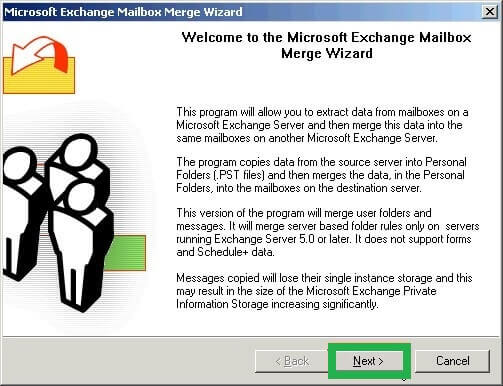
- Under Procedure Selection, select the second radio button Two-step procedure and click on Next.
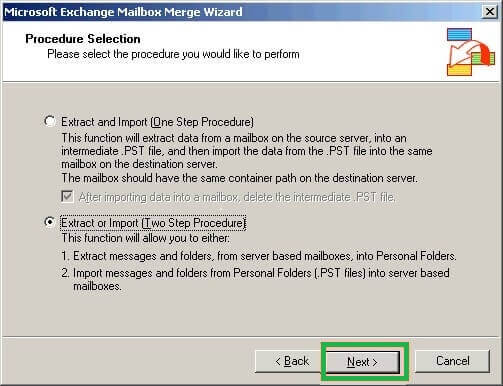
- Now, select the first option Extract data from Exchange Server Mailbox and click on Next.
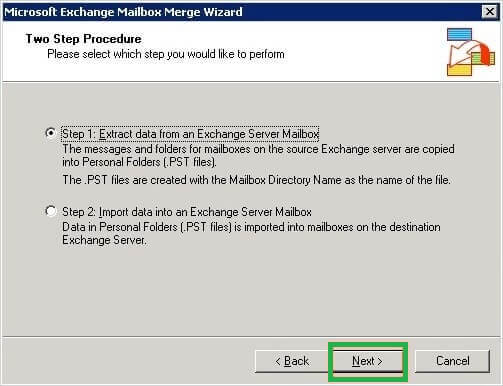
- In the Source Server window, provide your Exchange Server credentials like name, domain name, etc. and then click on Next to continue.
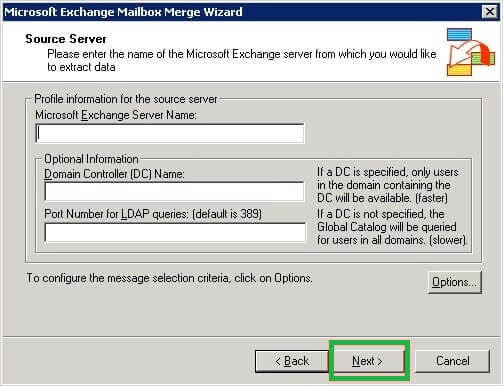
- Now, in the Data Selection Criteria, switch to the Import Procedure tab and then select the option Archive data to target store. Click on OK.
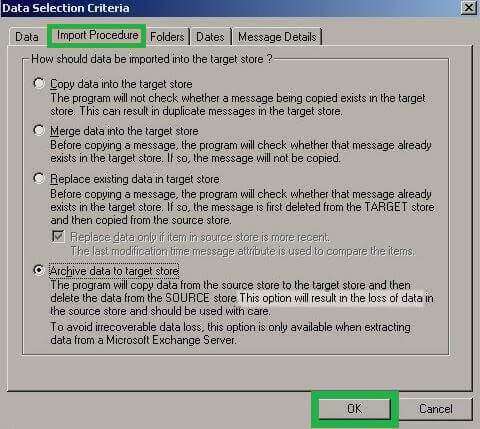
- In the next window, make selection of the EDB mailboxes for export and then click on Next.
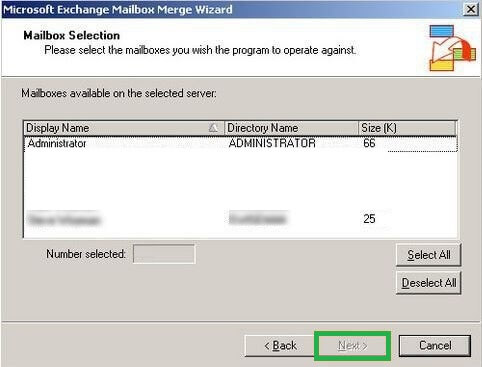
- Next, in Target Directory section, provide the destination path for the PST file at the system location. Click on Next to start the export process.
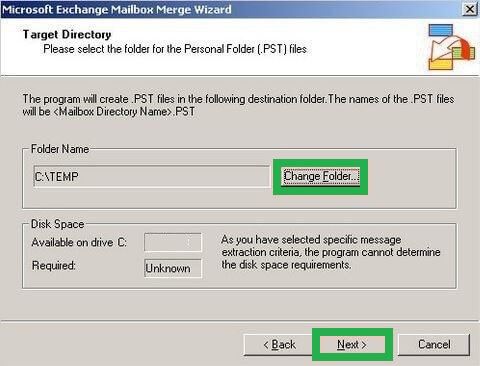
- You can see the progress of the export process. Once it is completed, click on Finish to exit the process.
- Hence, the EDB to PST conversion process is completed.
All these native solutions are free of cost but obviously they include certain limitations and possible risks during execution. Therefore, it is recommended to use a third party EDB to PST Converter tool for instant and efficient extraction of data. The best thing about this tool is that it does not have any above-mentioned limitations and also shows great compatibility with all Exchange Server and Outlook versions.
| EDB to PST Converter License Comparision | |
|---|---|
| Free Solution | EDB Converter Tool |
| Ex-Merge is long gone with Exchange 2003. | The software repairs database from Exchange 2003 easily. |
| Exchange Admin Center cannot connect with a corrupt database. | The software can access orphan or dismounted database files. |
| The Exchange Management Shell requires various levels of administrative permissions. | The software does not require any permission to access the database files. |
| The manual methods do not apply filter options. | The software offers multiple filter options. |
| The manual options take great time to complete the conversion process. | |
Conclusion
Different free processes are explained with limitations for converting EDB to PST file format for backup or other requirements. A user can decide on any method of choice depending on the convenience and ease of performance.

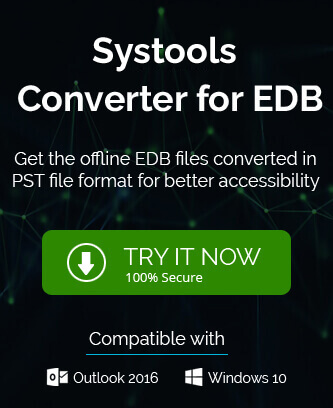
I was looking for a solution to export data from backup EDB file to Outlook PST, then by following the given Exchange Admin Center method I could get what I was looking for. The method is quick and easily manageable.
Finally, with the assistance of a friend, I discovered this blog for converting EDB to PST. Actually, I was looking for a manual method to complete this conversion when a friend suggested this blog. Using these methods, I was able to convert my EDB to PST. Thank you for sharing this important and helpful blog.
I used this method to convert my EDB files to PST. Every step in this blog is very clear and easy for users to follow. Initially, I have a little bit of an issue, but after reading carefully and applying the following steps, I get a satisfactory result. Otherwise, in case of a major issue, the author has suggested the third-party EDB Converter tool for the user’s convenience.
I used this method to convert an EDB file to Outlook PST format with all mailbox details. I experienced really good results with this Outlook method. . I just thanks to the writer for sharing this blog with users.
I was searching for a free method for EDB to PST conversion, and I found this blog having different methods in the simplest and easiest way.
This blog’s methods are very useful for me because I can easily convert my EDB files to PST format. I used this manual method many times. The author described this method in a very simple way. Thanks for sharing this amazing blog.
I tried this blog method, and I successfully converted my EDB files into PST format without any interruption. This blog method is very easy to understand, which is extremely beneficial to me for converting my files. I am thankful to the author for sharing this informative blog.
These blogging methods are extremely beneficial to me. Using this free method, I am able to easily convert my Exchange EDB to a PST file. I tried many methods, but no one could satisfy me. I am very thankful to the author for sharing this amazing blog.
I tried many methods to convert EDB files into PST format, but after trying this blogger methods, all my issues were solved easily. I am happy to use this method.
If you are looking for free methods to convert your Exchange EDB to PST file, this blog is best for you. The blog provided free solutions as per user’s requirement. Step by step instructions help me to get the exact result. Thanks for sharing good information.
To easily converts my EDB files into outlook PST format, this tool one of the best tool, which I have ever used so far. The methods told by a this blogger is easy to understand, Am thankful to this blogger for converting my EDB files.
To convert EDB file to PST I used this free method and it was amazing. As I followed the steps I reached to the result. Blog define a manual method in the simplest way I can understand easily what writers want to say. Thanks to writer for making this method accessible.
Above methods are explained really well and it helped me to convert EDB data to PST format. I suggests my friend to take a chance with this successful conversion method. They also tried it and get successful results. Thanks for sharing this blog.
In present blog three manual ways are described, which I used the most is, first one. It was very impressive and give me a clear way to export EDB file to PST. To apply the manual method you should have technical knowledge otherwise third party tool is the best option for you.
I used this method to convert EDB file to PST, in each step every detail are clearly mentioned. It helped a lot to gain perfect result.
The conversion process using first method is quite easy because of the wizard procedure. It helps to do process happening. I used it once and it worked for me and I could easily extract data from Offline EDB file.
Thanks Olaf for the methods you describe with pictorial description. But what if the user is not capable to run Exchange commands. I think the third party tool can perform it in better way, efficiently and securely.